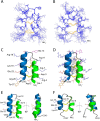Protein surface topography as a tool to enhance the selective activity of a potassium channel blocker
- PMID: 31533989
- PMCID: PMC6885618
- DOI: 10.1074/jbc.RA119.010494
Protein surface topography as a tool to enhance the selective activity of a potassium channel blocker
Abstract
Tk-hefu is an artificial peptide designed based on the α-hairpinin scaffold, which selectively blocks voltage-gated potassium channels Kv1.3. Here we present its spatial structure resolved by NMR spectroscopy and analyze its interaction with channels using computer modeling. We apply protein surface topography to suggest mutations and increase Tk-hefu affinity to the Kv1.3 channel isoform. We redesign the functional surface of Tk-hefu to better match the respective surface of the channel pore vestibule. The resulting peptide Tk-hefu-2 retains Kv1.3 selectivity and displays ∼15 times greater activity compared with Tk-hefu. We verify the mode of Tk-hefu-2 binding to the channel outer vestibule experimentally by site-directed mutagenesis. We argue that scaffold engineering aided by protein surface topography represents a reliable tool for design and optimization of specific ion channel ligands.
Keywords: alpha-hairpinin; hefutoxin; ion channel; molecular dynamics; neurotoxin; nuclear magnetic resonance (NMR); peptides; pore blocker; potassium channel; protein motif; protein structure.
© 2019 Berkut et al.
Conflict of interest statement
The authors declare that they have no conflicts of interest with the contents of this article
Figures





References
-
- Hille B. (2001) Ion channels of excitable membranes, 3rd Ed., Sinauer Associates, Inc., Sunderland, MA
Publication types
MeSH terms
Substances
Associated data
- Actions
- Actions
- Actions
- Actions
LinkOut - more resources
Full Text Sources

